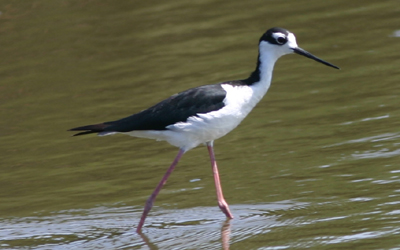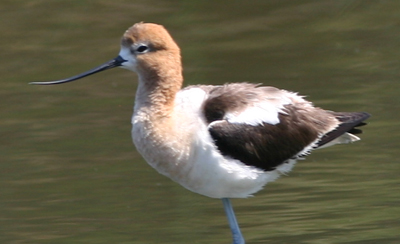My visit with my friend Jay, fantastic as it was, couldn’t be about birding. That essential activity was reserved for the next day, when I had the pleasure of meeting up with the WildBird herself, Amy. Last year, when Amy came out to my neck of the woods, we had a grand time at Jamaica Bay, one of my favorite spots for bird spotting on the Atlantic side of the country. Now, she was kind enough to share some of the abundant natural treasures out on the Pacific. First stop was the storied San Joaquin Wildlife Sanctuary in Irvine.
San Joaquin enjoys a high profile among the birding set not just because it’s the home of Sea & Sage Audubon, as impressive an Audubon chapter as I’ve ever enountered, but because of the exceptional avifauna. These 300 acres of coastal freshwater wetlands shelter some of the most remarkable populations of waterfowl and waders around. The very first birds to meet visitors are precariously long-legged Black-necked Stilts and creamsicle colored American Avocets. With ambassadors like these, it’s no wonder San Joaquin is renowned nationally.

Black-necked Stilt
Once I was able to look past these highly charismatic waders, some of the other denizens of the first pond came into view. In moments, I added two life birds I should have had a long time ago. The first was Western Sandpiper, apparently the only peep present at this time. The second, Cinnamon Teal, may not have been in its namesake rufescent plumage, but its small size, extended bill, and crimson eye set it apart easily from Mallard, the only other duck species in view. Along with Snowy Egret, Great Blue Heron, Black Phoebe, Mourning Dove, and one nesting Killdeer unfortunate to have chosen a spot far too close to the main path, the waders and ducks represented the species mix of that first bustling pond. The single exception was a quartet of ambiguous shorebirds that had Amy and I scratching our heads. We probably spent 15 minutes trying to reconcile those birds with the species, any species, in our field guides to no avail. With a promise to return, we toured the other ponds.
San Joaquin’s paths, bordered by dense walls of reeds on either side, are long, straight, and unshaded. This last trait conspired with the blazing noonday sun to make the place a literal as well as figurative hotspot. Amy and I fried as we found great birds like Common Yellowthroat, Pied-billed Grebe, and American Coot, then retreated to the sanctuary of the Audubon building. There, we met a lot of very friendly folks, including Bettina, a local naturalist who was willing to take a look at those mystery shorebirds and lead us to Yellow-breasted Chat in the bargain. Who could refuse such a kind offer?
The shorebirds proved frustratingly elusive to identify. It took three different field guides and some lively debate to ascertain that these birds weren’t sandpipers at all, but rather Wilson’s Phalaropes. That they were phalaropes made sense, as that species was one of our targets in this location. Unfortunately, Sibley’s let me down with this bird, since the illustration in the western field guide looks nothing like the juvenile bird in life. Bettina’s National Geographic guide was indispensible in making this call. I love your work, Sibley, but you should really address this error…
Bettina led us out towards the cottonwoods and willows where she earlier encountered tons of chats as well as Bell’s Vireo, a new species for me. Yellow-breasted Chat proved maddeningly discreet, coughing out their harsh calls but remaining out of sight. Under the blazing sun and wheeling Tree Swallows, Bettina’s persistence and expertise made the difference, as she magically whistled chats out of cover, albeit briefly, and got me on my first Bell’s Vireo. This vireo, Least no less, proved to be a much more colorful bird than I’d anticipated. Flush with success and sun, we hightailed it out of there past Nuttall’s and Downy Woodpeckers, American and Lesser Goldfinch, and the Cooper’s Hawk that had kept the songbirds silent. A glance back at the first pond revealed a lone Dowitcher that we determined to be Long-billed, my fifth lifer of the day!
San Joaquin is a superb slice of wetlands rich with banner birds. While I left cursing my own lack of foresight for not wearing a sombrero and dousing every inch of bare skin with sunblock, I am supremely grateful for Bettina for leading us on that Yellow-breasted Chat Death March and, of course, to Amy for bringing me to such a special habitat. The good news is that the day’s fun was just beginning…

American Avocet













Yes, it was ;^)
Mmmm, I love hunting for shorebirds in the summer heat.
How did the juvenile phalaropes you observed differ from Sibley’s illustration? Plumage? Bare-parts color? Structure? I’m interested in further details.
A great day Mike, you’ve got me looking forward to wader time.
Congrats on the life birds! It sounds like you guys had a good time. I’m interested in what part 2 will hold.
Mike, possibly the National Geographic depicts the pure juvenile plumage whereas the bird in Sibley’s guide is more advanced and shows a first-winter bird? But I really don’t know…
I’m not sure that’s the problem with Sibley’s, Jochen. We had Sibley’s Western, Kaufmann, and National Geographic all open to the bird and Sibley’s was least helpful. The bill on his juvenile phalarope is too thin compared to the real thing and the plumage is way too pale. The birds we spotted had varying amounts of pale rufous coming up the back of the neck and over the head. Coloration was more in line with Sibley’s Baird’s Sandpiper or even Stilt Sandpiper. National Geographic, on the other hand, had the birds right.
Thanks for the kind words Mike! I really enjoyed meeting both you and Amy and enjoyed the opportunity to take you out on the marsh again. Having spent many years and many magical moments birding the San Jouquin Wildlife Sanctuary I know how difficult it can be to identify some of the many waders that pass through in migration and, have had to let some go over the years. I think one of the problems in particular with the Wilson’s Phalarope and, the Red-necked Phalarope for that matter (although we wouldn’t expect to see the Red-necked yet), is that no two birds look alike. Yet, the overall “jizz” of the bird, head shape and size, bill shape and stoutness at the base, necklength and width, leg length and color, etc. in addition to coloration of the various feather tracts, make most of them “do”able. I am glad we worked it out. I only wish I could have gotten you even better looks at the Yellow-breasted Chat and the Least Bell’s Vireo. At least we had some songs and, those too of the Yellow Warbler. After you and Amy left, I ran into some folks I had met once before and we desided to go out for a ridiculous attempt at the Yellow-billed Cuckoo that I am sure was long gone (last reported two weeks ago). Anyway, glad I did because, after deciding that my skin could not take anymore punishment and after leaving them on the marsh, on my return trip to the Audubon House I encountered the best bird of the day, a California King Snake on the trail. Great end to a great day! Thanks for all the fun. Look me up next time your in California.